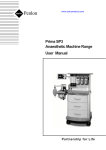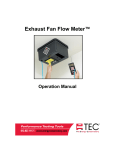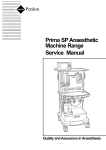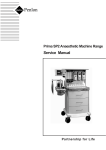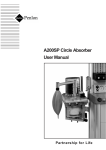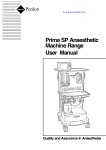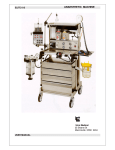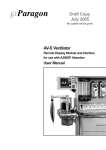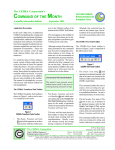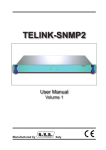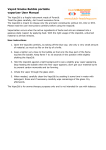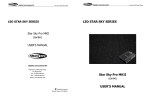Download SC430 User Manual- Machine
Transcript
SP2 Anaesthetic Machine Range User Manual IMPORTANT Servicing and Repairs In order to ensure the full operational life of this anaesthetic machine, servicing by an engineer trained by the manufacturer should be undertaken periodically. The machine must be serviced to the schedule detailed in section 6.4. Details of these service operations are given in the Service Manual for this product, available only for engineers trained by the manufacturer. For any enquiry regarding the servicing or repair of this machine, contact Paragon Service Paragon Service W. Bennet Sreet Saline MI 48176. Always give as much of the following information as possible: 1. 2. 3. 4. 5. Type of equipment Product name Serial number Approximate date of purchase Apparent fault (i) FOREWORD This manual has been produced to provide authorised personnel with information on the function, routine performance and maintenance checks applicable to the SP2 anaesthetic machine range. THE IMPORTANCE OF PATIENT MONITORING WARNING Anaesthetic systems have the capability to deliver mixtures of gases and vapours to the patient which could cause injury or death unless controlled by a qualified anaesthetist. Information contained in this manual is correct at the date of publication. The policy of the manufacturer is one of continued improvement to its products. Because of this policy, the manufacturer reserves the right to make any changes which may affect instructions in this manual, without giving prior notice. There can be considerable variation in the effect of anaesthetic drugs on individual patients so that the setting and observation of control levels on the anaesthesia systems does not in itself ensure total patient safety. Anaesthesia system monitors and patient monitors are very desirable aids for the anaesthetist but are not true clinical monitors as the condition of the patient is also dependent on his respiration and the functioning of his cardio-vascular system. Personnel must make themselves familiar with the contents of this manual and the machine’s function before using the apparatus. IT IS ESSENTIAL THAT THESE ELEMENTS ARE MONITORED FREQUENTLY AND REGULARLY AND THAT ANY OBSERVATIONS ARE GIVEN PRECEDENCE OVER MACHINE CONTROL PARAMETERS IN JUDGING THE STATE OF A CLINICAL PROCEDURE. (ii) CONTENTS Page No. USER RESPONSIBILITY 1 1. WARNINGS AND CAUTIONS 2 2. PURPOSE 4 DESCRIPTION 5 5 5 6 3. 3.1 3.2 Framework and General Construction Gas Circuit Gas Circuit Schematic 3.3 3.4 3.5 3.6 3.7 3.8 3.9 3.10 3.11 3.12 3.13 Gas Supply Safety Devices Mechanical Anti Hypoxic Device (AHD) Pressure Gauges Flowmeters and Controls Vaporizers Common Gas Outlet (CGO) Electrical Power Supply Auxiliary Gas Outlets A200SP Absorber AV-S Ventilator MRI Compatibility 7 8 8 9 10 10 11 12 12 12 13 4. SPECIFICATION 14 4.1 Physical Dimensions 14 4.2 Gas Supplies 15 4.3 Flowmeters 15 4.4 Gas Pressures 16 4.5 Auxiliary Gas Outlets 16 4.6 Oxygen Failure Warning Devices 17 4.7 Oxygen Flush 17 4.8 Mechanical AHD System 17 4.9 Environmental (including MRI compatibility) 17 4.11 Electrical Supply 18 5. PRE-USE CHECKS 19 5.1 Pre-use Check List 19 5.2 Pre-use Checks - Gas Supply 21 5.2.1 Gas Pipeline Supplies 21 5.2.2 Gas Cylinder Supplies 21 5.2.3 Flowmeters 22 5.3 Vaporizers 23 5.4 Electrical Supply 24 (iii) CONTENTS 5.5 Patient Breathing System 25 5.6 Leak Rate Check - Low pressure gas System 28 5.7 Oxygen Flush 28 5.8 Anaesthetic Gas Scavenge System (AGSS) 28 5.9 Ventilator 28 5.10 Alarm System Testing 29 6. 6.1 6.2 6.3 USER MAINTENANCE Cleaning and Sterilisation A200SP Absorber Service Schedule 30 31 32 APPENDIX Product Classification and Labelling Terminology (iv) 33 USER RESPONSIBILITY This anaesthetic machine has been built to conform with the specification and operating procedures stated in this manual and/or accompanying labels and notices when checked, assembled, operated, maintained and serviced in accordance with these instructions. Statements in this manual preceded by the following words are of special significance: To ensure the safety of this device it must be checked and serviced to at least the minimum standards laid out in this manual. A defective, or suspected defective, product must not under any circumstances be used. The user must accept responsibility for any malfunction which results from noncompliance with the servicing requirements detailed in this manual. WARNING means there is a possibility of injury to yourself or others. CAUTION means there is a possibility of damage to the apparatus or other property. NOTE indicates points of particular interest for more efficient and convenient operation. Always take particular notice of the warnings, cautions and notes provided throughout this manual. Additionally, the user must accept responsibility for any malfunction which may result from misuse of any kind or noncompliance with other requirements detailed in this manual. Worn, broken, distorted, contaminated or missing components must be replaced immediately. Should such a repair become necessary it is recommended that a request for service advice be made to Paragon Service . This device and any of its constituent parts must be repaired only in accordance with written instructions issued by the manufacturer and must not be altered or modified in any way without the written approval of the manufacturer. The user of this equipment shall have the sole responsibility for any malfunction which results from improper use, maintenance, repair, damage or alteration by anyone other than the manufacturer or Paragon Service. USA and Canadian Federal Law restricts the sale and use of this device to, or on the order of, a licensed practitioner. 1 1. WARNINGS AND CAUTIONS accidentally tipped, resulting in excessive and uncalibrated volumes of anaesthetic drug entering the breathing system The following WARNINGS and CAUTIONS must be read and understood before using this anaesthetic apparatus. Do not install or connect any vaporizers of any description between the Common Gas Outlet (CGO) and the breathing system unless they are specifically designed for such use. (If this is done, the oxygen flush flow will pass through the vaporizer and may result in gross overdosage when the flush valve is operated.) WARNINGS 1. This apparatus is designed for use only with non flammable anaesthetic agents. It must not be used with or in close proximity to flammable anaesthetic agents, due to a possible fire or explosion hazard. 2. Exterior panels must not be removed by unauthorised personnel and the apparatus must not be operated with such panels missing. On machines with an electrical power supply, there is a possible electric shock hazard. 3. No oil, grease or other flammable lubricant or sealant must be used on any part of the machine in close proximity to medical gas distribution components. There is a risk of fire or explosion. 4. When attaching cylinders of medical gases ensure that the machine yoke and cylinder faces are dust free and clean and that the sealing washer provided is in position between the cylinder valve and the yoke. Tighten the yoke securely before opening the cylinder valve. Dust and dirt presents a fire hazard in the presence of high pressure gas. Leakage of high pressure gas can cause serious injury. 5. 6. Anaesthesia apparatus must be connected to an anaesthetic gas scavenging system (AGSS) to dispose of waste gas and prevent possible health hazards to operating room staff. This requirement must be observed during test procedures as well as during use with a patient. The machine must only be used with Delta vaporizers (or other vaporizers approved by the manufacturer) installed by means of the Cagemount or Selectatec system. Free-standing vaporizers may be 2 7. The breathing system which conveys gases from the anaesthetic machine to the patient and disposes of expired gases is a vital part of the anaesthetic delivery system. Because breathing systems require frequent cleaning and disinfection they are not a permanent part of the anaesthetic machine and therefore cannot be directly under the control of the anaesthetic machine manufacturer. However, we strongly recommend that only breathing systems which have been approved and authorised by the manufacturer for use with the SP range should be employed. This is particularly important when mechanical ventilation is employed. 8. When mechanical ventilation is employed the patient breathing system must be connected directly to an overpressure relief valve to prevent the possibility of barotrauma. 9. Always perform a pre-use check of the machine, including vaporizers, ventilator, circle absorber and monitors before clinical use. Follow the pre-use checklist (see section 5) as a minimum requirement. Many clinical incidents occur because of a failure to check for correct function. 10. The machine must not be used if any of the alarm, monitoring or protection system devices are not functioning correctly. 11. The machine must not be fitted with more than four operator accessible mains socket outlets. There is a risk of an excessive leakage current. WARNINGS AND CAUTIONS 12. 13. The use of antistatic or electrically conductive breathing hoses is not recommended when using high frequency electrical surgery equipment (e.g. : Diathermy). Burns may be caused. needle valve from fully closing. This ensures a minimum basal flow of oxygen. DO NOT attempt to close the flow to zero. Do not overtighten. Before any electrically powered machine is used clinically for the first time, check that the hospital engineering department has carried out an earth continuity test. 14. Before using any additional electrical equipment powered by the auxiliary sockets on the machine, check that the additional equipment is correctly wired and is earthed through its plug. A missing or defective protective earth conductor may increase earth leakage currents to the patient to values exceeding the allowable limits, resulting in ventricular fibrillation, or interference with the pumping action of the heart. 15. Additional equipment placed on the top shelf must be securely attached. Take care when moving a fully loaded machine, particularly when negotiating ramps. Check that hoses or power leads are not trailing on the floor. CAUTIONS 1. Flowmeter needle valves are designed to seal with light torque and may be damaged if tightened excessively. Do not force the control knob past either the fully open or fully closed positions. 2. Open cylinder valves slowly to avoid damage to pressure reducing valves. Ensure that cylinder valves are at least one full turn open when in use. 3. Under no circumstances should anaesthetic agents be used for cleaning purposes. 4. After use, always disconnect the machine from the piped gas supply and/or close the gas cylinder valves. 5. Mechanical AHD system - The oxygen flow control is restricted to prevent the 3 6. Compressed gas supplies must be clean and dry. 7. When the auxiliary gas outlets are in use on a machine with cylinder supply only, or if the pipeline supply is not in use, check flow rate requirements, and ensure that adequate back-up cylinders are available. 2. PURPOSE The SP2 anaesthesia workstation range is intended to provide controlled concentrations and flows of anaesthesia gases into a patient breathing system, from where the anaesthesia ventilator and breathing circuit will then deliver this fresh gas mixture to the patient Use the machine in conjunction with anaesthetic vaporizers, breathing hoses and patient connection fittings which comply with the relevant ISO standard or equivalent. Depending upon the patient circuit selected, the machines can be used in open, semiopen, semi-closed or closed circuit configurations. The range has been designed to give a wide choice of configurations and accessories, as follows: Gas supplies Up to three gases Oxygen, nitrous oxide, and air, with pinindex cylinder yokes, and provision for up to three pipeline supply inlets. Vaporizer mounting systems Backbar manifold for Selectatec Compatible, or Cagemount type vaporizers. Anti-hypoxic Device (AHD) The mechanical AHD system is designed to minimise the risk of a hypoxic mixture reaching the patient, see section 3. 4 3. DESCRIPTION 3.1 General Construction Frame The machine has a cast aluminium base, extruded aluminium uprights, with aluminium and plastic panels. 1 Mobility Four castors are fitted, with a brake on each of the front castors. The castors are five inches diameter. A footrest is built into the front of the machine and, to aid manoeuvrability, two handles are provided. Pipeline Inlets (1) Up to three, rear mounted pipeline gas inlets can be fitted. Pipeline supply hoses are connected by non-interchangeable, screw threaded unions (DISS). Mounting posts and brackets A mounting system is built into each side upright, to allow the use of pole-mount brackets, V-brackets, and ventilator mounting brackets. The pole mount upright can be used to mount an A200SP Absorber assembly. Filters To prevent dirt entering the gas system, cylinder yokes and pipeline inlets are fitted with filters. Work surfaces The work surface has raised edges to retain instruments, vials etc. A pull-out writing tablet is mounted under the work surface. 3.2 Gas Inlet Block Each individual cylinder or pipeline supply, is routed through a separate gas block. Each gas block has an integral high pressure gauge tapping for direct mounting of a pressure gauge, and a non-return valve to prevent back flow of gas. In addition, cylinder gas blocks have a diaphragm pressure regulator to reduce the pressure of the compressed gas supply, and a factory set pressure relief valve. This prevents pressure build up under the diaphragm should any leakage develop across the reducing valve seat. Gas Circuit Gas Circuit Schematic A gas circuit schematic are shown on the following page. All available gas supply options are shown. Gas Supplies A variety of cylinder and pipeline combinations can be added to the basic specification of oxygen and nitrous oxide cylinder and pipeline supply. For example, two extra gas cylinders (choose from one additional oxygen, one additional nitrous oxide, one air), and one extra pipeline supply - Air. Secondary Pressure Regulator A second stage regulator reduces the pressure supplied to each flowmeter control (see section 4). The fitment of a secondary regulator for oxygen and nitrous oxide enhances the performance of the mechanical AHD system. Secondary regulation of the air supply aids the stabilisation of the output at the flowmeter. Cylinder Yokes The yokes are rear mounted and conform with ISO standards for pin-index fitting. To ensure that only cylinders of the appropriate gas may be installed the yokes are designed so that the retaining latch cannot be closed unless the index pins are fully engaged. 5 SP2 USA specification threegas machine with dual cascade oxygen and nitrous oxide flowmeters. O2 Air N2O Flowmeter Assembly Gas Tray O2 Pneumatic pressure source N 2O Air Gas cut-off valve (normally open) Filter Pressure gauge Pressure regulator Flowmeter Vaporizer Pneumatic switch (optional Air/N2O interlock) Oxygen flush valve Reservoir Non-return valve Pressure relief valve Pneumatic on/off switch Power take-off point (or test point) Audible alarm Restrictor Flow control valve (variable) 6 Visual indicator DESCRIPTION 3.3 Gas Supply Safety Devices 3.3.1 Gas Supply Cut-off Device A gas cut-off device, triggered by low oxygen supply pressure, cuts the supply of nitrous oxide, and carbon dioxide (if fitted). The cut-off operates when the oxygen pressure falls to 186 ±14 kPa (27 ±2 psig). 1 Gas supplies are reinstated only when the oxygen supply pressure rises above 227 ±14 kPa (33 ±2 psig). 3.3.2 Oxygen Supply Failure Warning Whistle A whistle gives an audible warning when there is a reduction of oxygen supply pressure. Operated solely by the remaining oxygen in the machine system, the warning whistle is prolonged by an oxygen reservoir built into the gas circuit, allowing a minimum warning whistle of 7 seconds duration. 3.3.4 Oxygen Supply Visual Indicator The indicator (1) is mounted on the front of the machine and is operated from the oxygen supply and shows GREEN when the supply is at working pressure, and RED if the pressure falls. 3.3.5 Mechanical AHD A mechanical link between the oxygen control valve and a needle valve in the nitrous oxide flow ensures that the machine delivers a fresh gas mixture with a minimum 30% (±3%) oxygen, irrespective of the flow of nitrous oxide set by the anaesthetist. With the nitrous oxide control valve fully open, the oxygen and nitrous oxide flows are then both controlled by the oxygen control valve. The whistle will start to sound when the pressure falls to 200 ±21kPa (29 ±3 psig), and will continue to sound until the pressure falls to approximately 70 kPa (10 psig). Oxygen consumption of the whistle is approximately 2 L/min when sounding and nil at other times. See section 3.4 for a full description 3.3.6 Low Pressure Gas Tubing Diameter-indexed tubing is used for the low pressure gas system - see section 4. 3.3.3 Fresh Gas Pressure Relief Valve A pressure relief valve is mounted between the vaporizer back bar and the common gas outlet (CGO) on the inside face of the machine right hand upright. It is designed to prevent fresh gas being delivered to the breathing system at pressures exceeding 41 kPa (6 psi). This valve also protects machine components against excessive pressure in the event of a total blockage of the CGO. 7 DESCRIPTION 3.4 Mechanical AHD (Anti Hypoxic Device) 3.4.1 Introduction The Mechanical AHD is housed within the flowmeter module and comprises a gear linkage between the oxygen control valve and a needle valve in the nitrous oxide flow. 1 The system controls the relative flow rates of oxygen and nitrous oxide. A predetermined minimum oxygen concentration of 30% ±3% in the oxygen / nitrous oxide mixture is maintained over the flow range to prevent delivery of a hypoxic mixture. Therefore, for any oxygen flow set by the user, the mixture delivered will still contain a minimum 30% ±3% oxygen even with the nitrous oxide control knob fully open. As the nitrous oxide knob is progressively closed, the oxygen content of the mixture increases to 100%. 3.4.2 Gas Delivery Switch The Gas Delivery Switch (1) operates on the oxygen supply and must be in the ‘On’ position for normal operation of the anaesthetic machine. The switch consequently controls the supply of all gases provided with a gas cut-off triggered by a predetermined pressure level within the oxygen supply (see section 3.3.1). 3.4.4 Oxygen Basal Flow To allow the system to function correctly, an oxygen basal flow is continuously supplied. Single Flow Tubes: 100 - 200 ml/min Dual Cascade System Flow Tubes: 50 - 75 ml/min This basal flow can only be turned on and off by using the Gas Delivery Switch. A whistle (oxygen failure warning whistle) will sound briefly whenever the gas delivery switch is turned on or off. Note that the whistle functions continuously if the oxygen supply fails (see section 3.3.2). CAUTION The oxygen control is restricted to prevent the needle valve from fully closing. This ensures a minimum oxygen basal flow. DO NOT attempt to close the flow to zero. Do not overtighten the knob. NOTE The switch also controls the electrical supply to the optional flowmeter lighting unit. 3.5 Pressure Gauges Pressure gauges (50 mm diameter) are located on the front panel below the flowmeter bank. The gauge for Air is positioned between oxygen and nitrous oxide. Unused gauge positions are blanked out. All pressure gauges are colour coded and labelled for the gases whose pressures they are indicating. Cylinder gauges are marked: CYLINDER. Pipeline gauges are marked: PIPELINE. The gauges are calibrated in kPa x 100. 3.4.3 Gear Linkage and Nitrous Oxide Control Valves A gear linkage connects the oxygen control knob on the flowmeter module and a needle valve in the nitrous oxide flow. This linkage limits the flow of nitrous oxide relative to the flow of oxygen set by the user. Note that this needle valve acts as the primary nitrous oxide valve, and is actuated only by movement of the oxygen control. The nitrous oxide control knob on the flowmeter module operates a secondary needle valve in the nitrous oxide flow. It is positioned downstream of the primary valve and therefore is used only to restrict the flow already set by the primary valve, which itself has been determined by the position of the oxygen control knob. 8 DESCRIPTION 3.6 3.6.2 Dual Cascade Flow Tubes The flow of gas through dual cascade system flow tubes always flows through the low-flow tube first. The high-flow tube should not show any flow until more than 1 L/min is set. At flows above 1 L/min, the high-flow tube reading indicates the rate of flow for that gas. Flowmeters and Controls 3.6.1 All models The flowmeters, mounted behind the perspex cover on the left hand side of the machine, are length-indexed to prevent inadvertent, incorrect installation. All floats indicate flow rate in line with the upper surface as shown below. 3.6.3 Read flow at this level Auxiliary Oxygen Flowmeter An auxiliary oxygen flowmeter (1) is mounted to the left of the machine flowmeter bank. Each flow control valve is positioned directly underneath the flow tube assembly to which it corresponds, and the control knob is colour-coded for the gas which it controls. 1 The oxygen flow control knob is made physically distinguishable from the other flow controls for identification by touch in accordance with ISO standards. When fitted, air and carbon dioxide flowmeters are always installed in the inner positions on the flowmeter assembly. These positions are blanked out if air or carbon dioxide are not specified for the machine. The gas delivery switch, positioned on the front panel controls the supply of oxygen and must be in the ON position for normal operation of the machine. Flow control of each gas is achieved by a needle valve comprising a polished stainless steel needle mounted concentrically in a common manifold block. To minimise wear and material pick-up the needle seat is manufactured from silver. The flow control knob is turned counter-clockwise to increase the gas flow. CAUTION Needle valves are designed to seal with light torque and may be damaged if tightened excessively. DO NOT USE EXCESSIVE FORCE. 9 DESCRIPTION 3.7 Vaporizers 3.7.3 Cagemount Vaporizer Vaporizers fitted with cagemount tapers have the male taper (inlet port) on the left, and the female taper on the right (viewing the front of the vaporizer). CAUTION Read the instruction manual supplied with the vaporizer before clinical use. 3.7.1 Vaporizer Mounting Systems Vaporizers for the administration of volatile anaesthetic agents can be fitted as follows: (a) (b) It is recommended that detachable cagemount connectors are retained with a safety clip (catalogue number 52275) to prevent inadvertent disconnection. Delta Selectatec compatible vaporizers, mounted on a Selectatec compatible universal backbar. Delta Cagemount vaporizers mounted on a Modura rail (check that relevant national standards for your country allow fitment of more than one cagemount type vaporizer). 3.8 WARNING Vaporizers must always be securely mounted, and never used free-standing. Unmounted vaporizers may be accidentally tipped resulting in uncalibrated and excessive volumes of liquid anaesthetic drug entering the breathing system. Common Gas Outlet (CGO) 1 Vaporizers of any description must not be installed or connected between the Common Gas Outlet (CGO) and the Breathing System, unless they are specifically designed for such use. (If this is done, the oxygen flush flow will pass through the vaporizer, and severe overdosage may result). The outlet (1) is at the rear of the machine, and has a 22 mm male taper and concentric 15 mm female taper. The male taper incorporates Safelock system designed to prevent accidental disconnection of the breathing system. 3.7.2 Selectatec Compatible Vaporizer Selectatec compatible vaporizers, (e.g. Delta with the Selectatec connector block), may be mounted on a universal back bar manifold, built onto the machine as an option. A two-station manifold is provided, with each station fitted with two valve capsule assemblies for vaporizer connector block attachment. 2 Oxygen Flush An emergency oxygen flush valve button (2) is mounted at the font of the machine and is marked ‘O2 FLUSH’. Depressing the button provides a delivery of between 35-75 litres/min of oxygen through the common gas outlet (1). Releasing the button allows the springloaded valve to return to its normal position. When a vaporizer is installed on a station the valves on that station open automatically to allow gas flow into and out of the vaporizer. Removal of the vaporizer from the station closes the valves on that station. Selectatec compatible vaporizer interlock systems are described in the literature supplied with the vaporizer. 10 DESCRIPTION 3.9.4 Ventilator Power Supply The mains lead for an AV-series ventilator can be plugged into one of the auxiliary power sockets on the rear of the machine. 1 AV-S with interface link to anaesthetic machine (See section 3.15) a) b) c) 3.9 Turn the machine Gas Delivery Switch ON. The ventilator will power-up. While the machine power is ON, the Ventilator can be turned OFF and ON, using the ventilator On/Off switch. Turn the Gas Delivery Switch to OFF. The ventilator will power-down. AV-S Ventilator Back-up Battery If the power supply to the ventilator fails, the ventilator back-up battery will power the ventilator for 30 minutes, if the battery has been maintained in a fully charged condition. Refer also to the user instruction manual supplied with the ventilator Electrical Power Supply 3.9.1 Mains Power Supply Power is fed to the machine via the mains lead, to power an auxiliary output panel, and optional flowmeter bank light. Current Leakage Battery charging takes place automatically when the ventilator mains lead is connected to a ‘live’ mains supply. The OFF indicator on the ventilator front control panel will show a yellow light during charging. NOTE a) It is the user’s responsibility to ensure that the total sum of leakage currents from additional equipment plugged into the auxiliary sockets plus the leakage current from the machine does not exceed the values specified in any relevant national standards that may apply in the country where the machine is in use. b) Each socket is protected with two 5 A fuses. NOTE The stated battery back-up period will only be available if the battery is kept fully charged. If the battery has been allowed to discharge below the LOW BATTERY condition, the ventilator will not function correctly until the voltage raises above the LOW BATTERY level. A fourteen hours recharge will be necessary to bring the battery to full charge. 3.9.2 Auxiliary Power Supply Sockets An optional mains electricity auxiliary panel with four sockets can be specified, and fitted to the rear of the machine. The supply to the sockets is controlled by an ON/OFF switch (1), which also incorporates a circuit breaker. 3.9.5 Monitor and other Accessories The mains lead (or adaptor) for a monitor system or other accessories requiring an electrical supply can be plugged into one of the auxiliary sockets on the rear of the machine. 3.9.3 Flowmeter Bank Lighting The lighting system is controlled by the main ON/OFF switch (1). 11 DESCRIPTION 3.10 Auxiliary Gas Outlets CAUTION When the auxiliary gas outlets are in use on a machine with cylinder supply only, or if the pipeline supply is not in use, check flow rate requirements, and ensure that adequate back-up cylinders are available. 1 Oxygen and Air Auxiliary outlets (1) are mounted on the rear of the machine. Supply pressure See section 4.5 3.11 A200SP Absorber The A200SP Absorber and ventilator bellows assembly is mounted on a polemount bracket attached to the machine frame upright. Refer to the user instruction manual for A200SP for detailed information on installation and operation. 3.12 AV-S Ventilator Interface to anaesthetic machine An interface cable links the rear of the ventilator control unit to the gas delivery switch on the anaesthetic machine. Ventilator ON/OFF function a) b) c) Turn the machine Gas Delivery Switch (C) ON. The ventilator will power-up. While the machine power is ON, the Ventilator can be turned OFF and ON, using the ventilator On/Off switch (refer to ventilator user manual. Turn the Gas Delivery Switch to OFF. The ventilator will power-down. Refer to the user instruction manual for AV-S for detailed information on installation and operation. 12 DESCRIPTION 3.13 MRI Compatibility CAUTION Field strengths vary at individual MRI facilities - for additional information, contact Paragon. The following system components are MRI compatible: 1. SP2 basic* machine *A 'basic' machine includes any variant of Back Bar Flowmeter Bank Drawers Monitor Shelves 2. A200SP Absorber CAUTION A200SP Absorber is normally part of an SP2 integrated system with the AV-S - this system is not MRI compatible. 3. Nuffield 200 Ventilator 4. Delta Vaporizer The following components are currently not MRI compatible: 1. 2. 3. 4. Oxygen Monitor Flowmeter lighting Electrical power outlets AV-series ventilator NOTE a) MRI Compatible Plastic Laryngoscopes contact Paragon. b) The IDP Pressure Failure Alarm must be: a) mounted securely and b) fitted with appropriate batteries contact Paragon. 13 4. SPECIFICATION 4.1 Physical Dimensions Overall frame size: Height x Width x Depth (cm) 139 x 71 x 70 Work surface Height: Size: Loading: 86 cm 58 cm x 25 cm 30 kg (66 lb) - evenly distributed. Writing tablet: 30 x 22 cm Top shelf: Loading: 71 cm x 35 cm 30 kg (66 lb) - evenly distributed. Drawers: Loading: 12 x 54.5 x 35 cm 10 kg (22 lb) evenly distributed Castors: Diameter: 5 inches Front pair braked Ventilator bellows post Bushed to accept 25.4 mm (1 inch) or 22 mm (7/8 inch) poles. 30 kg (66 lb) Loading Gas scavenging fixing Loading Bracket on frame upright 30 kg (66 lb) Common gas outlet: 22 mm male taper with coaxial 15 mm female taper connections, Safelock fitting Weight (approximate, depending on specification): 75 kg (165 lb) 14 SPECIFICATION 4.2 Gas Supplies Cylinders: A maximum of four cylinder fittings can be specified All cylinder yokes are pin-indexed Special order options: Helium, Xenon Pipeline: Maximum of three (oxygen, nitrous oxide, air). All to relevant national standards. Medical gas colour codes: Oxygen Nitrous oxide Medical air Carbon dioxide Helium Xenon green or White* Blue Yellow or Black/White* Grey Brown Green (bright) *To comply with relevant national standards. Internal pipework is diameter indexed for each gas: Oxygen: Nitrous oxide Air Mixed gas 8 mm 6 mm 5 mm 10 mm Carbon Dioxide: Helium Xenon 4 mm 4 mm 4 mm 4.3 Flowmeters Flow ranges: Single flow tubes Oxygen: Nitrous Oxide: Air Helium Cascade flow tubes Oxygen /Air /Nitrous Oxide 0 - 10 0 - 10 0 - 10 0 - 10 (1) (2) L/min L/min L/min L/min 0 - 1000 ml/min 0 - 10 L/min Flowmeter Accuracy The accuracy of the flowmeter tubes is ± 2.5% of full scale reading. 15 SPECIFICATION Flowmeter construction and dimensions Tubes and floats are matched, and must not be interchanged. Flowmeter tubes have antistatic coatings. Tubes are length indexed: Oxygen Nitrous oxide Other gases 260 mm (10.24 inch) 250 mm (9.84 inch) 240 mm (9.45 inch) (see 3.12) Scale length 152 mm (6 in) minimum (all flow tubes except carbon dioxide) 4.4 Gas Pressures USA/ Canada/Japan Pipeline supplies: 340 kPa (50 psig) UK 400 kPa (58 psig) Cylinder supplies: Reduced pressure from regulator (at 5 L/min flow) 310 kPa +15 kPa / -35 kPa (45 psig +2 psig / -5 psig) 380 kPa +15 kPa / -35 kPa (55 psig +2 psig / -5 psig) Regulator diaphragm bursting pressure 2800 kPa (406 psig) 2800 kPa (406 psig) Reduced pressure system safety valve 600 kPa (87 psig) 600 kPa (87 psig) Safety valve (to protect flowmeter, vaporizer etc.) 41 kPa ±10% (6 psi ±10%) 41 kPa ±10% (6 psi ±10%) Reduced pressure from secondary regulators (at 5 L/min flow) Oxygen and Nitrous Oxide 152 - 241 kPa (22 - 35 psi) Air 207 - 283 kPa (30 - 41 psi) 4.5 Auxiliary Gas Outlets Pipeline supply: Cylinder supply: Gas is supplied at pipeline supply pressure (see above) Gas is supplied at reduced pressure from cylinder regulator (see above) Oxygen Two self sealing connections on rear of machine Total flow rate: not less than 100 L/min to free air 80 L/min against 243 kPa (36 psig) resistance 70 L/min against 270 kPa (40 psig) resistance 50 L/min against 297 kPa (44 psig) resistance Air (on machines with Air supply option) One self sealing connection on rear of machine. 16 SPECIFICATION 4.6 Oxygen Failure Warning Devices 1. 2. 4.7 Gas system whistle Visual indicator, direct pressure operated Oxygen Flush Button on front edge of worksurface The system supplies 35 - 75 L/min when fully depressed. 4.8 Mechanical AHD System Minimum oxygen concentration 30% ±3% (of total O2 + N2O flow) Basal Flow Cascade flow tubes Oxygen basal flow 50-75 ml/min Single Flow tubes Oxygen basal flow 100-200 ml/min Reduced pressure from secondary regulators: See section 4.4. 4.9 Environmental Operating Conditions Temperature Atmospheric Pressure range Altitude Humidity +10 to 38oC (50 to 100oF) 70 kPa to 106 kPa 2438 m (8000 ft) maximum 10 - 95% R.H. non-condensing. Transport and storage temperature: Basic machine Oxygen monitor option Cleaning -5 to 60oC (23 to 140oF) -5 to 50oC (23 to 122oF ) Wipe external surfaces with dry or damp cloth. Use mild soap, or disinfectant solution if necessary. 17 SPECIFICATION MRI Compatibility See additional notes in section 3.16. The following components are MRI compatible: Basic machine (includes any variant of Back Bar, Flowmeter Bank, Drawers, Monitor Shelves, Additional Gases) A100 (In-board and pole-mounted) A200SP Absorber Caution - A200SP is normally fitted as part of an integrated system, comprising anaesthetic machine and AV-series electronic ventilator - this system is not MRI compatible. Nuffield 200 Ventilator Delta Vaporizer IDP Pressure Failure Alarm (when secured to the machine, and used with appropriate batteries) The following components are currently not MRI compatible: Oxygen Monitor, Flowmeter lighting, Electrical power outlets, AV-series ventilator 4.10 Electrical Supply Standard: Optional: 6 amp, 110-120 V, 60 Hz 5.5 amp, 220-240 V, 50 Hz Permanently attached 3 metre lead. Stowage hooks for cable on rear. Auxiliary electrical power outlets : Max. total current: 4 outlets 5A 18 5. PRE-USE CHECKS 5.1 Pre-use Checklist A pre-use checklist for the anaesthetic machine range is printed on the next page. This checklist is also supplied with the machine. Where necessary, subsequent sections in this manual provide an explanation and procedure for setting up the machine and ancillary equipment and the various checks that must be carried out before clinical use. WARNING Pre-use checks must be performed before each period of clinical use. These checks must be supplemented by periodic Function Testing, and full Service Testing by an engineer trained by the manufacturer, to the Service Schedule given in the Service Manual. These checks will not in themselves ensure the safe use of the apparatus, which remains the responsibility of the qualified practitioner in charge of it. 19 PRE-USE CHECKS PRE-USE CHECKLIST The machine must be carefully inspected and checked as follows. An incorrectly functioning machine must be repaired by a suitably qualified person before use. 1. 2. 3. 4. 5. 6. 7. 8. 9. 10. 11. Check for visible damage, machine stability, and condition of gas supply hoses. Check for labelling which may indicate status of machine, including faults or recent servicing. Check correct connection of electrical supply. Check correct connections of gas supplies. Check adequate pipeline supply and back-up cylinder supply. Switch on gas delivery switch, and note special operating system: Check functioning of flowmeters. Check function of Mechanical AHD, Check correct connection and functioning of the vaporizers. Check functioning of oxygen flush. Check leak rate of low pressure gas system. Check the integrity of the patient circuit. Test the alarm system. Refer to Section 5 in the User Manual for further information. 12. 13. 14. Ancillary equipment Check operation of the AGSS. Check functioning of ventilator, including disconnect alarm. Check that the oxygen analyser and other patient monitoring equipment functions correctly. Refer to the relevant user manual for further information. 20 PRE-USE CHECKS 5.2 Pre-use Checks - Gas Supply 5.2.1 Gas Pipeline Supplies Oxygen supply: 1. Connect the oxygen pipeline hose only. Check that the correct pressure gauge reading is obtained. 2. Turn on the Gas Delivery switch (1). Check that the warning whistle sounds briefly, and that the correct basal flow of oxygen is delivered (see section 3.8). 3. Open both oxygen and nitrous oxide flowmeter valves. Check that flow is only shown in the oxygen flowmeter. 4. Close both valves. Turn off the Gas Delivery switch. Check that the warning whistle sounds briefly, and that the oxygen basal flow is stopped. Nitrous Oxide supply: 5. Connect the Nitrous Oxide pipeline hose. Check the gauge reading. Turn on the Gas Delivery switch (1). Check for a flow of nitrous oxide when the flowmeter needle valve is operated. NOTE: cylinder supply can be used if necessary for this test. Air supply: 6. Connect the Air pipeline hose. Check the gauge reading. Check for a flow of air when the flowmeter needle valve is operated. 5.2.2 Gas Cylinder Supplies CAUTION Open the cylinder valves slowly to avoid damage to the pressure reducing valve and pressure gauges. Ensure that valves are at least one full turn open when in use. 1. Fit the gas cylinders to their respective yokes, open the cylinder valves one at a time and check the pressure on each gauge. NOTE A) When two cylinders are provided for a single gas, test each separately, clearing pressure after each test by opening the flowmeter valve. B) Turn off the reserve cylinders during normal use. C) N2O - cylinder pressure does not indicate cylinder content. 2. Ensure that all flowmeters are kept closed until gas supplies are required. 21 CAUTION The mechanical AHD system requires that the oxygen flowmeter control is restricted to prevent the needle valve from fully closing. This ensures a minimum oxygen basal flow. DO NOT attempt to close the flow to zero. Do not overtighten the knob. 1 PRE-USE CHECKS 5.2.3 Flowmeters 1. Turn on the Gas Delivery switch (1) and check that the warning whistle sounds briefly briefly, and that the correct basal flow of oxygen is delivered (see section 4). 2. Open the nitrous oxide flowmeter needle valve and check that there is no nitrous oxide flow. 3. Operate the oxygen flowmeter needle valve. Check that full scale of flow of oxygen and nitrous oxide can be achieved, and that the floats in both tubes move freely and rotate when at a steady flow. 4. Check that the nitrous oxide flow can be turned off by gentle rotation of the oxygen knob. Check also that the nitrous oxide float reseats on the bottom stop, and that the oxygen basal flow continues to flow. 5. Operate the other flowmeter control knobs in turn to check: the full scale of flow can be obtained; the floats move freely and rotate at a steady flow; the flow can be turned off by gentle rotation of the knob; and that the floats reseat on the bottom stop. 6. Dual cascade flow tubes: Check that gas flow is through the low flow tube initially until full flow is achieved, then through the high flow tube. 7. Auxiliary flowmeter (2) Rotate the flowmeter control and check that a gas flow can be obtained. 2 1 22 PRE-USE CHECKS 5.3 5.3.1 5.3.4 Vaporizers WARNING Only vaporizers with the Selectatec compatible interlock function will interlock if installed on a two station manifold. The installation of non-interlock vaporizers allows the possible operation of more than one vaporizer at the same time. Pre-use Checks On ALL vaporizers, before use: 1. Check all joints for gas tightness. 2. Check vaporizer agent level. 3. Check for correct agent delivery concentrations - use an agent analyser. Check that the interlock mechanisms of all the vaporizers on the manifold are working correctly, i.e. check that only one vaporizer at a time can be turned on. Always follow the procedures and checklist given in the instruction manual supplied with the vaporizer, particularly when filling the vaporizer with anaesthetic agent. 5.3.2 Selectatec Compatible Vaporizers with Interlock General Information WARNING Vaporizers must always be mounted, never used free-standing. Free standing vaporizers may be accidentally tipped resulting in excessive and uncalibrated volumes of anaesthetic drug entering the breathing system. Do not install or connect any vaporizer of any description between the CGO and the breathing system, unless it is specifically designed for such use. (This allows the oxygen flush flow to pass through the vaporizer, and severe overdosage may result). 5.3.3 Selectatec Mounting System Dependent on choice of backbar manifold system, up to two Selectatec compatible vaporizers may be fitted. To install the vaporizer, carefully offer the vaporizer up to the manifold. Check that the gas connection ports on the vaporizer are aligned with the valves on the manifold. Carefully lower the vaporizer onto the manifold and lock the vaporizer into position by clockwise rotation of the locking lever through 90o. NOTE Do not use excessive force to lock the vaporizer onto the manifold. Damage to the locking fastener will result. CAUTION To prevent damage to the locking shaft, ensure that the gas connection ports are aligned with the valves on the manifold, and are correctly engaged, before tightening the locking lever. 23 PRE-USE CHECKS 5.4 Electrical Supply 1. Connect the machine power lead to a suitable mains supply socket. 2. Set the switch (1) to ON. Check for correct function of each auxiliary power outlet 3. Check all electrical equipment, including devices powered by the auxiliary power outlets on the rear of the machine. 4. Machines with optional flowmeter lighting: Check for correct operation. 24 1 PRE-USE CHECKS - All models 5.5 Patient Breathing System 5.5.1 Hose Connections Check that all hoses are secure. 5.5.2 Breathing System Hose, Reservoir Bag, Ventilator Connectors for the Inspiratory hose and Expiratory hose, and the reservoir bag connector are 22 mm male. All connectors comply with ISO 5356/1. The ventilator connection point is also 22 mm male. Hose and bag connections are fitted with Safelock high security fittings. Check all connections for gas tightness. 5.5.3 Fresh Gas Supply The fresh gas hose assembly supplied with the machine has a connector at the absorber inlet and a 22 mm Safelock taper at the other end. This should be connected to the common gas outlet of the anaesthetic machine. Check all connections for gas tightness. 5.5.4 A200SP Absorber Always follow the pre-use check procedures given in the instruction manual supplied with the absorber. The use of an oxygen monitor (and a carbon dioxide analyser) is highly recommended when using any partial rebreathing anaesthetic system. 3 A200SP Connections 1. 2. 3. 4. 5. 6. 7. 8. 9. Inspiratory connector Expiratory connector Bag connector Inlet - from DRIVE GAS outlet on ventilator control unit. Inlet - fresh gas hose from Common Gas Outlet Exhaust outlet from APL Valve - connect to Anaesthetic Gas Scavenge System Oxygen monitor sensor Outlet - sample line to Pressure Monitor Port on ventilator Interface cable - Bag/Vent switch and spirometer (connects internally to machine On/Off Switch interface, then to connector on ventilator control unit rear panel). 2 1 7 9 6 4 5 8 25 PRE-USE CHECKS 25 3 31 23 24 26 2 20 19 30 18 12 1 4 11 10 21 16 27 14 29 26 28 15 6 13 5 17 22 12 Note 9 7 8 1. AV-S has spirometry and oxygen monitor. 2. Interface cabling is shown for machine On/Off switch and A200SP Bag/Vent switch. 1. Bellows 18. Drive Gas Inlet - Ventilator 2. Ventilator Control Unit 19. Drive gas Outlet - ventilator control unit to bellows 3. Outlets to Anaesthetic Gas Scavenging System (AGSS) 20. Outlet - Exhaust Valve 4. Bacterial Filter 21. Inlet - Bellows Drive Gas 5. Absorber valve block 22. Outlet - to breathing system 6. Heat and moisture exchanger 23. Input socket - Oxygen monitor sensor 7. Patient 24. Input socket - machine interface 8. CGO Block on anaesthetic machine (Fresh Gas Supply) 9. Auxiliary Outlet on anaesthetic machine (Drive Gas Supply) 25. Input socket: 10. Flow sensor - expiratory (i) A200SP Absorber Bag/Vent control position 11. Flow sensor - inspiratory (ii) Spirometer sensor signal 12 Connectors - sensor - pressure monitor 26. Interface connections on machine and A200SP 13. Expiratory Valve - Absorber 27. APL Valve 14. Inspiratory Valve - Absorber 28. Outlet from APL Valve to AGSS 15. Inlet - from Ventilator Bellows 29. Oxygen sensor 16. Connector - Reservoir Bag 30. Ventilator remote screen 17. Inlet - Absorber - Fresh Gas Supply 31. Cable ( ventilator control unit to remote screen) (machine on/off switch) 26 PRE-USE CHECKS 5.5.5 Note 1. Breathing Circuit Schematic To protect the expiratory limb of the breathing circuit, and the spirometer, use a breathing circuit bacterial filter (4), and a heat and moisture exchanger (6) at the patient Y-piece. CAUTION Replacement/Disposal - always follow the instructions supplied with the filter or heat and moisture exchanger. Always renew components at the recommended interval. 2. Follow the instructions in the relevant user manual for connection to analysers and monitors. 3. Ventilator connections shown are for AV-S with spirometry and oxygen monitor. 4. For A200SP, refer also to the user documentation supplied with the absorber. 5.5.6 System Low Pressure Leak Test Connect the CGO outlet on the machine to the fresh gas inlet of the A200SP absorber. 3 4 NOTE This machine must be fitted with a breathing system complying with approved design parameters, at the selection of the qualified practitioner. 6 5 The breathing system components do not constitute part of the machine but connections between the machine and breathing system should be verified as follows: 1. 2 1 Fit a patient circuit to the inspiratory connector (1) and expiratory connector (2) on the absorber, and a breathing bag to the bag arm connector (3). 2. Set the bag/ventilator switch (4) on the absorber to ‘Bag’ 3. Close the adjustable pressure limiting (APL) valve (5), and occlude the patient connection port on the patient circuit. Press the oxygen flush valve button on the front of the machine briefly. Check that the reservoir bag inflates and the manometer (6) indicates approximately 40 cmH2O. 27 4. Release the oxygen flush valve. Check that the pressure is maintained in the system with less than 200 ml/min fresh gas delivered into the breathing system, showing that no leaks are present. 5. If this test fails, check the low pressure system on the machine (section 5.6). If the low pressure test on the machine is successful, check the ventilator and absorber, referring to the relevant user instruction manual. PRE-USE CHECKS 5.6 Machine Low Pressure Leak Test 5.8 By inspection, check that all sources of expired anaesthetic gases, e.g. the absorber APL valve, and the ventilator bellows patient gas exhaust port, are connected to an approved collection system leading to an AGSS. NOTE This test is necessary if the system fails the low pressure test 5.5.6. 1. 2. 3. Attach a side branch connector to the CGO outlet. Connect the side branch tube to a sphygmomanometer. Turn on a flow of 150 ml/min of oxygen. Block the open port of the connector with a finger. The pressure in the low pressure gas system will rise and be displayed on the sphygmomanometer. Check that the pressure rises to at least 100 mmHg. Release the finger seal immediately the pressure is reached. WARNING Vacuum systems must not be connected directly to the APL valve on the absorber. A receiving system with a positive and negative pressure control function must be interposed. Systems must comply with standard ISO 8835 part 2. 5.9 Ventilator Always follow the pre-use check procedures given in the ventilator instruction manual. Check all hose and tubing connections for gas tightness. Check all wiring connections for correct fitment and security. CAUTION Do not maintain closure of the open port longer than necessary to perform the test. This test should be performed: (a) With all vaporizers ‘off’ and isolated. (b) With each vaporizer in turn set to 1%. AV-S Ventilator Check for correct fitment of the interface cable at each connector. NOTE This test is equivalent to (and in some cases exceeds) the requiremets for system leakage rates quoted in national standards worlwide. Check the interface system function: a) b) 5.7 Anaesthetic Gas Scavenge System (AGSS) Oxygen Flush c) Check for a high flow of oxygen through the CGO outlet when the flush valve button is pressed and that the flow ceases when the button is released. This test is most conveniently done after the breathing system has been attached, using the reservoir bag as an indicator of gas flow. 28 Turn the Gas Delivery Switch ON. The ventilator will power-up. While the machine power is ON, the ventilator can be turned off and on, using the ventilator On/Off switch. Turn the Gas Delivery Switch to OFF. The ventilator will power-down. PRE-USE CHECKS 5.10 Alarm System Test WARNING The anaesthetic machine must not be used if any alarm is not functioning correctly. Primary Oxygen Failure Alarm The machine is fitted with a warning whistle and a visual indicator (1). These components act as oxygen supply failure devices and constitute the primary alarm system, powered only by the residual oxygen supply, as described in section 3. The system can be checked whenever the low pressure oxygen system is first pressurised by turning on a cylinder or connecting a pipeline. a) The whistle will sound briefly as pressure increases, and, b) The visual indicator will turn from red to green. Whistle, Visual Indicator, and Gas Cut-off Device Test A formal test (including the action of the internal gas cut-off device) is performed as follows: 1. Connect oxygen, nitrous oxide and air supplies. 2. Set the Gas Delivery switch (2) to ON, and check that the warning whistle sounds briefly. 3. Set a flow of 2 L/min on both flowmeters. 4. Disconnect the oxygen supply at the wall socket or close the oxygen cylinder valve and check: a) that as the oxygen flow slows down, the whistle starts to sound and continues for at least 7 seconds. b) that the flow of nitrous oxide is cut off completely before the oxygen flowmeter shows zero flow. c) that the visual indicator (1) turns red before the oxygen flow is entirely stopped. d) air continues to flow. NOTE All gases must be included in the pre- use check. 5. Reinstate the oxygen supply. Check that the flow of nitrous oxide is reinstated, and that the visual indicator turns green again. 29 2 1 6. USER MAINTENANCE IMPORTANT User Maintenance is restricted to cleaning the external surfaces of the machine All other maintenance and servicing must only be carried out by an engineer trained by the manufacturer. The machine must be only be serviced according to the schedule and procedures given in the Service Manual. Ancillary Equipment Follow the instructions given in the relevant user manual for detailed information on maintenance and service requirements for the ancillary equipment used with the anaesthetic machine: Vaporizers Ventilator Absorber AGSS Monitoring 6.1 Cleaning and Sterilisation Frequently wipe over the external surfaces of the machine with a damp cloth. Mild antiseptic solutions may be used but should be rinsed off with clean water. Always allow the machine to dry off thoroughly before clinical use. Breathing system hoses and other components must be sterilised to the manufacturer’s recommended methods. 30 USER MAINTENANCE 6.2 A200SP Absorber 6.2.1 Removing the Absorber Assembly CAUTION The canister (1) may contain condensate. Before removing the absorber from the pole-mount assembly, refer to the A200SP user manual for instructions on draining the canister and disposing of absorbent. 1. 2. Set the brakes on the anaesthetic machine front castors. Slacken the knob (2), and lift the absorber assembly from the polemount. 2 1 31 USER MAINTENANCE 6.3 Service Schedules 6.3.1 Anaesthetic Machine The anaesthetic machine must be serviced to the following service schedule: 6 months 12 months 2 and 4 years Inspection and Function Check Annual service which includes routine replacement of seals, etc. as preventive maintenance Additional tests and component replacement Details of these service operations are given in the Service Manual, available only to engineers trained by the manufacturer. 6.3.2 Delta Vaporizer Follow the instructions given in section 8 of the vaporizer user instruction manual. Servicing includes a periodic leak test and calibration test, and a major overhaul at 10 years (5 years for Halothane models). On vaporizers with interlock, the system must be tested during the vaporizer calibration test. 6.3.3 Monitoring Systems Follow the service recommendations monitor user instruction manual. detailed in the 6.3.4 AV-S Ventilator If the anaesthetic machine was supplied with an AVseries ventilator, refer to section 7 of the ventilator user instruction manual, for servicing requirements. These include: 6 months Inspection and Function Check 12 months Replace bellows Replace O seals and drive gas inlet filter, etc. 24 and 48 months Additional component replacement 6.3.5 A200 Absorber 6 months Inspection and Function Check 12 months Component replacement. 48 months Additional component replacement 6.3.5 Anaesthetic Gas Scavenging System Follow the service recommendations detailed in the AGSS user instruction manual. 32 APPENDIX APPENDIX Product Classification and Labelling Terminology The terms Class 1 and Type B are defined in IEC 601-1 (the standard for electrical medical equipment). This symbol denotes: Type B equipment Type B equipment calls for a particular degree of protection against electric shock. Class 1 equipment has additional protection such that metal parts of the unit that are accessible to the user (e.g. the metal casing of the oxygen monitor unit) cannot become live in the event of failure of the basic insulation of the electrical components within the unit. This symbol denotes: Refer to the User Manual 33 ! Paragon Service W. Bennet Sreet Saline MI 48176 Doc. No. PR SP2 0105 July 2005 Manufactured by: Penlon Limited Abingdon UK.










































